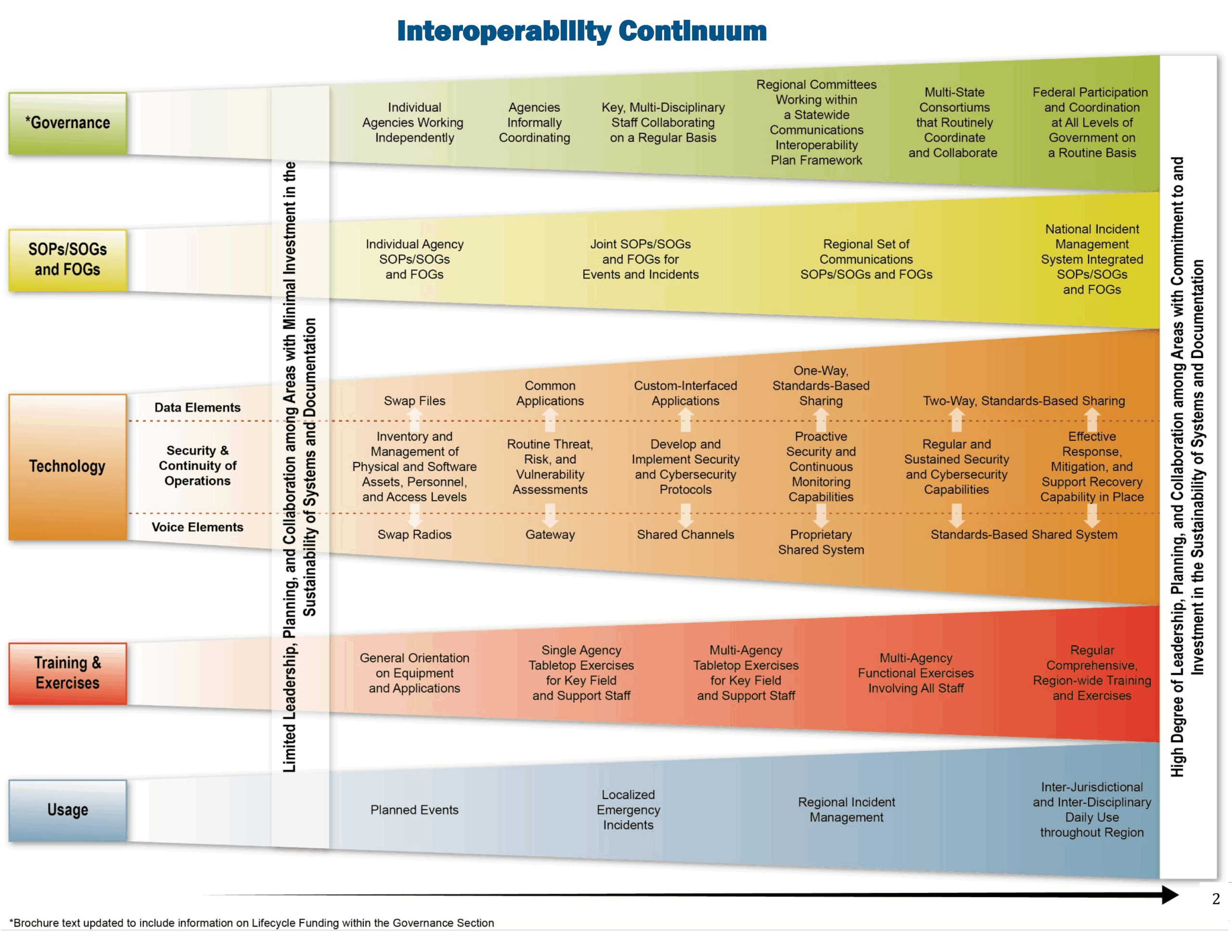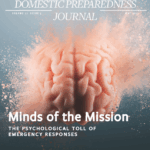Public safety interoperability, at its core, is the art of sharing emergency information across boundaries—between technologies, disciplines, organizations, and levels of government. These boundaries act as barriers to collaborating, coordinating, and communicating. Interoperability efforts have been guided by the SAFECOM Interoperability Continuum, a stakeholder-driven framework developed after the September 11, 2001, terror attacks. The Continuum focuses leaders and practitioners within various “lanes” of effort, namely governance, standard operating procedures (SOP) and guides, technology, training and exercises, and usage. Decades of work have improved public safety’s ability to change the channel, both literally on radios and metaphorically in the culture of information sharing. However, the journey toward better interoperable communication requires uncovering additional hidden barriers. Fortunately, starting this work does not have to be difficult.
The following discussion introduces a series of questions that can be used to examine response SOPs to uncover hidden barriers to interoperable communication.

Talk Early About Talking
Consider response policies for a fast-moving, multi-agency event, such as an active assailant incident, during which coordination between responding agencies and personnel is critical. An active assailant SOP focuses initially on the physical movements of law enforcement and other resources, and for good reason.
- In the initial response, who has responsibility for establishing shared voice communications between contact officers and subsequent responders and when?
- Is it considered only after units are dispatched or, worse, after they arrive and make contact?
The first hidden barrier to interoperability, then, is placing emergency communications too far into the plan. Communication enables operations, and channels must be available and established before they are needed. If responders, including public safety telecommunicators (sometimes referred to as “dispatchers”), cannot communicate when the emergency begins, they will struggle to change communications as the incident increases in scope, complexity, and risk. If the first mention of communications, or interoperability, is several steps or pages into a policy, now is the time to start updating it.
Assign Responsibility and Empower Personnel
Placing interoperability early in an SOP is only the first step. The next step is to examine the language around establishing communications. Hidden barriers include responsibility-shifting, unassertive language, unclear authority, and assumptions of simultaneous situational awareness.
Avoid language that encourages waiting and discourages acting. For example, “Command may request a channel” and “Upon declaration of a level-one event, a tactical channel may be assigned” both encourage passivity, directing personnel to wait for formal requests, declarations, or recognitions. Conditional words such as “if” and “upon” discourage decision-making and real-time information sharing (e.g., “Why was a shared fire and medical channel not established?” “They didn’t ask for it.”). Another example is the phrase “If a channel is needed.” When multiple agencies and disciplines respond to a life-threatening event, a channel is needed.
Operational policies use triggers and event inputs to prompt changes in responder posture and behavior. However, critical incidents often move quickly, with rapidly changing conditions that do not precisely align with planning assumptions:
- What if interoperability is tied too closely to a trigger that does not occur or is not defined as such in the SOP?
- Are personnel empowered to use alternate voice resources (channels, talk groups, patches, etc.) during non-SOP-defined triggers? If not, responders will be left unaware of each other’s positions, actions, and needs at critical moments.
Unified command only solves some challenges and is not a substitute for real-time sharing of lifesaving information during critical incidents.
One solution is to explicitly define the authority of responders in an SOP, especially public safety telecommunicators, to establish shared voice resources early and shift operations to alternate communications paths when needed. Rather than fret over the exact operational steps or circumstances that trigger action, consider defining that authority explicitly in an SOP’s planning assumptions or other foundational sections.
Critical incidents require interoperable communication, both in the field and at the emergency communications center. SOPs should affirm that with language that clearly assigns responsibility and encourages early action. Public safety telecommunicators have the most comprehensive view of an emergency before field personnel arrive. They are strategically positioned to recognize the need for interoperability and to assign the right resources at the right time.
Finally, examine SOPs for unrealistic assumptions about how and when personnel will gain situational awareness:
- Does the plan account for asynchronous identification of triggers and conditions that would result in operational changes?
- Does the plan assume everyone will recognize those triggers at the same time and simultaneously take appropriate action?
- Are responders prepared to coordinate if they do not recognize triggers simultaneously? They will be if they have already engaged in interoperable communication.
Expand the Table
The real world may not adhere to public safety planning assumptions. Like the apocryphal frog in the boiling pot of water, responders can find themselves unable to communicate because the language of the SOP hides them from (or prevents them from acting on) the increasing operational temperature. Keep communication simple by inviting the right partners to planning meetings to answer the following questions:
- Does the land mobile radio system have the capacity to assign all responding personnel to a shared, interoperable talk group or channel upon dispatch?
- Does the emergency communications center have staffing to manage the additional resources?
- For smaller, more constrained systems, is there a defined simplex (local unit-to-unit only) radio channel available for responders on scene?
- Who will maintain communication back to the emergency communications center?
Advance interoperability by inviting the people with these answers to the planning table. Preparing for the 2018 and 2019 anniversaries of the “Unite the Right” rally in Charlottesville, Virginia, planners did just this. The incident management team identified a communications unit leader early in the planning cycle. That leader, along with key technical leads, attended strategy and tactics meetings. They worked directly with operational planners to understand their needs and create plans and systems that worked. Connect experienced communicators with operational planners before the emergency so that responders can be connected when they need it.
Do Not Be the Frog

These are just a few thoughts taken from the author’s reviews of real policies and public safety tabletop and full-scale exercise evaluations of kinetic events, primarily in Virginia. Secondary attention to communication, unassertive language, assumptions of simultaneous situational awareness, and lack of empowerment have led to preventable communication failures. In one exercise, more than one “unified command” was established at different locations. Fire and emergency medical services units never spoke with each other on the radio, and a casualty collection point was established in a dangerous zone. Most responders were on a shared trunked radio system, but common talkgroups were not assigned. Critical information was not shared, resources were placed in harm’s way, and lifesaving actions were delayed. Luckily, these were only exercises. Personnel knew their jobs and followed their policies, but the hidden barriers trapped them like the frog.
Take time now to review and update operational policies for all kinds of events. Expand the planning table and make time for intentional discussion about interoperability. Challenge planning assumptions and look for hidden barriers to communicating. Activate willing and capable responders by empowering them to communicate. Do not be the frog.

Gabe Elias
Gabe Elias is the statewide interoperability coordinator (SWIC) for the Commonwealth of Virginia. He advocates for collaboration and coordination across the emergency communications ecosystem, including operational communications, data sharing, alerts and warnings, and 911. As SWIC, he provides connectivity between multiple regional, state, and federal governing bodies and committees working in the communications discipline. Prior to this role, he served for over 20 years managing technology, projects, and systems staff at the Charlottesville–UVA–Albemarle County Emergency Communications Center. He is a past president of the Virginia Chapter of APCO International.
- Gabe Eliashttps://disasterpreparedness.kinsta.cloud/author/gabe-elias






